

 Village Profile
on
Village Profile
on
Mawkaton Village under Nongstoin C&RD
Block
District: West Khasi Hills District
7th March, 2021.
COMMUNITY LED LANDSCAPE MANAGEMENT
PROJECT
(CLLMP)


The Government of Meghalaya with financial help from the world Bank is implementing the Meghalaya Community Led Landscape Management Project (MCLLMP). The Project will cover the entire State of Meghalaya and implementation of community led plans will be rolled out in phase manner throughout the state. The Meghalaya Basin Management Agency will facilitate community led planning by providing support, technical inputs, and funding.
The project is intended to strengthen community led natural resources management in selected landscape within the 11 Districts of the state. This would be achieved through a variety of planning, capacity building, and on- the ground interventions to promote the conservation sustainable use of natural resources, social inclusion, and community mobilization, building traditional knowledge and learning, mapping of natural resources management, strengthening the community institutions and creating linkage with financial institutions and community organizations.
The project interventions will include preparation of community led natural resource management plans. The CLLMP has the following three components:
Strengthening Knowledge and Capacity of communities for Natural resource management
Community Led- Landscape Planning and Implementation
Project Management and Governance
Objective:
The project objective is “to manage and conserve the natural resources, especially forests, soil and water sources, in a manner that supports the financial and physical well- being of communities in the State.”
The CLLMP- Programme focuses on increasing the capacities of communities and traditional institutions by adopting a landscape approach to manage their natural resources such as soil, Springs and other water resources forest and bio-diversity etc.
The Project will be planned and implemented in about400 villages across the State
CLLMP has a strong focus on institution building at the village level, by ensuring systematic capacity building on technical and social skill sets
The project also extends such training to communities beyond the targeted villages and support efforts made by them to access funding from various rural and natural resources initiatives and schemes.
The Programme will also invest in improving the process and outcome delivery, by developing adhering to effective systems and procedures, supported by the appropriate technology.
Benefits:
Benefits for community (skills and capacity relating to technical and managerial areas like NRM and conflict resolution
Benefits to traditional institutions (village councils, traditional leaders, community- based organizations, SHGs etc.) through knowledge sharing, promotion of innovative approach, access to technology, technical managerial and financial support.
It is estimated that the project will impact around 1 lakh partners (of which 50% are women) who depend on land, forest, Agro-forestry.
Through the project, 55000 Ha of targeted area will be ensured with availability of water, biological resources, and soil productivity, which will in turn benefit around 400 villages and the outcomes delivery can summarized as follows.
The Project will be executed by the MBMA in collaboration with other partners particularly, SIRD (for training and capacity building), Department of Soil and Water conservation, Water Resource Department, Forest Department, specifically with respect to technical inputs, safeguards management and community NRM plan preparation.
2018-2023(5 years).
| Sl. No. | Topics | Page No. |
|---|---|---|
| I. | Introduction & History | 5 |
| II. | Social Profile | 6 |
|
7-9 | |
| III. | CLLMP Activities | 10 |
|
10-27 | |
 Mawkaton village is
situated at Nongstoin C&RD Block, West Khasi Hills District, at
14 km from Nongstoin, the District Headquarters. The village falls
under Hima Mariaw with a total population of 840 villagers.
Mawkaton village is
situated at Nongstoin C&RD Block, West Khasi Hills District, at
14 km from Nongstoin, the District Headquarters. The village falls
under Hima Mariaw with a total population of 840 villagers.
The beginning of Mawkaton village dates to hundred years ago but there is no precise information on the year it was established. The people who first inhabited Mawkaton belonged to the Marngar Clan from Hima Myriaw. As per folktales, these people settled in hilly and forest areas near Laitkseh village but due to mosquito infection, the people decided to settle in a plain landscape. As days passed by, the population increased and people from other clan came and settled permanently and these clan consisted of Nongphud clan, Marthong clan, Lyngkhoi and others. In the olden days, the people of the village built their houses on top of a rock and they used stones for stairs to climb. Therefore, the people named the village as Mawkaton which meant ‘stones on top of the other.’
Mawkaton village has a total number of 135 households and a population of 710 villagers out of which 307 are males and 403are females. The village has 99children in the age group 0-4 years. Among them, 49 are boys and 50 are girls. Farming and allied activities are the main source of livelihood while few are engaged in other sectors like teaching and business.
Village Accessibility:
In order to reach Mawkaton village one must venture through Nongkasen road and take right turn to reach the destination.
Literacy: As per 2011 census, Mawkaton village has reached 57%. There are three schools in the village- 1 Lower Primary and 3 Upper Primary Schools.
Presently, the village is managed and guided by the Dorbar as the highest authority for the welfare of the community which is alternatively comprised of the Seng Kynthei (Women Wing) and Seng Samla (Youth Wing) all collectively aiming for the overall development and growth of the village. There are other committees such as the VEC, Village Water and Sanitation Committee, Self-Help Group cooperatively working for the betterment and development of the village.
1. Population: As per 2011 census, Mawkaton population was 542 and in 2023 the population of Mawkaton increased to 710. Out of this, 307 are males and 403 are females. The village has 99 children in the age group of 0-4 years. Among them 49 are boys and 50 are girls.
| Age group | Male | Female | Total |
|---|---|---|---|
| 0-4 | 49 | 50 | 99 |
| 5-14 | 91 | 88 | 179 |
| 15-30 | 62 | 136 | 198 |
| 30-60 | 81 | 99 | 180 |
| Above 60 | 24 | 30 | 54 |
BPL/APL Household:
| Particulars | NO. of HHs |
|---|---|
| BPL HH | 112 |
| APL HH | 15 |
2. Card Holding Household:
| Particulars | No. of Household |
|---|---|
| Total HH | 127 |
| Ration Card HH | 127 |
Fuel type:
| Fuel Type | Total HH |
|---|---|
| Charcoal | 0 |
| Wood | 90 |
| LPG | 45 |
| Electric Heater | 0 |
| Kerosene | 0 |

3. Occupation: Majority of the people depend on agriculture and other allied activities for their livelihood. The main occupation of the people is farming followed by other services such as teaching, self-employed and other local business.

4. Key Constraints: There is shortage drinking water in winter season compare to summer season.
 5.
Land Use Land Cover Pattern:
5.
Land Use Land Cover Pattern:
Water bodies: Spring-5, Natural pond-1, Streams-4, River-1, and Fish ponds -5.
Forest: 52.49ha.
1. Ground Truthing:
On the 2nd May 2019, the CLLMP officials met with Shri. I.E. Nongphud, Headman of Mawkaton village and other village representatives for field assessment. Shri. I. E. Nongphud provided the team with important information regarding the current scenario of the landscape and the natural resource management under his Headmanship.
Case Findings:
There are a total of 135 households out of which --------- HH falls under BPL and ---------- HH under APL category.
It has an actively performing VEC.
There is inadequate supply of drinking water especially in winter.
Few patches of degraded land left unused.
Deforestation is high which lead to the loss of natural vegetation.
Abundance of spring water.
2. Sensitization Programme:
The Sensitization Programme of Mawkaton village was conducted on 19th June, 2019, where the District Project Manager and other CLLMP officials emphasized on the Community Led Landscape Management Project. A total of 72 Villagers actively participated in the program, voiced out their concerns and questions regarding the project making it a huge success.
Highlights of the Meeting:
Awareness about the Community-Landscape Management Project.
Laying importance on the involvement of the community in making the CNRM plan and its success.
A brief awareness on cleanliness was conducted based on the findings during the ground truthing phase.
An interactive session was held to answer the doubts of the villagers regarding the project.
2.1 Signing of EOI, VGA and Green Charter:
Mawkaton village signed the Expression of Interest (EOI), the Village Grant Agreement (VGA) and the Green Charter on the 21st August, 20219, after a uniform agreement by the entire community that the Community Led Landscape Management Project (CLLMP) be implemented at Mawkaton village.
2.2 Formation of VNMRC:
The formation of the Village Natural Resource Management Committee was done in a public meeting in the Presence of the entire village and the CLLMP staffs. The Community chose the President, The Secretary, and other executive members of the committee.
List below are the members of VNMRC:
| Village Natural Resource Management Committee (9member committee constituted from Village Council and VEC, SHG group, Women’s group, Youth;4 members should be women) | ||||||||
|---|---|---|---|---|---|---|---|---|
| Sl No | Name in Full | Gender M/F | Age (in Yrs) | Education | Designation | Occupation | Community | Contact No. |
| 1 | Toniwell Marthong |
M | 33 | VI | President | Farmer | Khasi | 9862086589 |
| 2 | Happiness Lyngkhoi |
F | 40 | X | Secretary | Farmer | Khasi | 8974005237 |
| 3 | Bestolin Lyngkhoi |
F | 44 | X | Finance | CRC(SSA) | Khasi | 6909819030 |
| 4 | Etris Marthong |
F | 30 | BA | Member | Teacher | Khasi | 7085712975 |
| 5 | Abinsen Lyngkhoi |
M | 32 | VI | Member | Farmer | Khasi | 8974002829 |
| 6 | Brosilda Marngar |
F | 52 | V | Member | Farmer | Khasi | NA |
| 7 | Tensingh Turnia |
M | 57 | BA | Member | Teacher | Khasi | 9862140343 |
| 8 | T.R. Jyndiang |
M | 57 | XII | Member | Gram Sevak | Khasi | 9615463102 |
| 9 | Drinstina Marngar |
F | 50 | NA | Member | Helper (ICDS) | Khasi | NA |
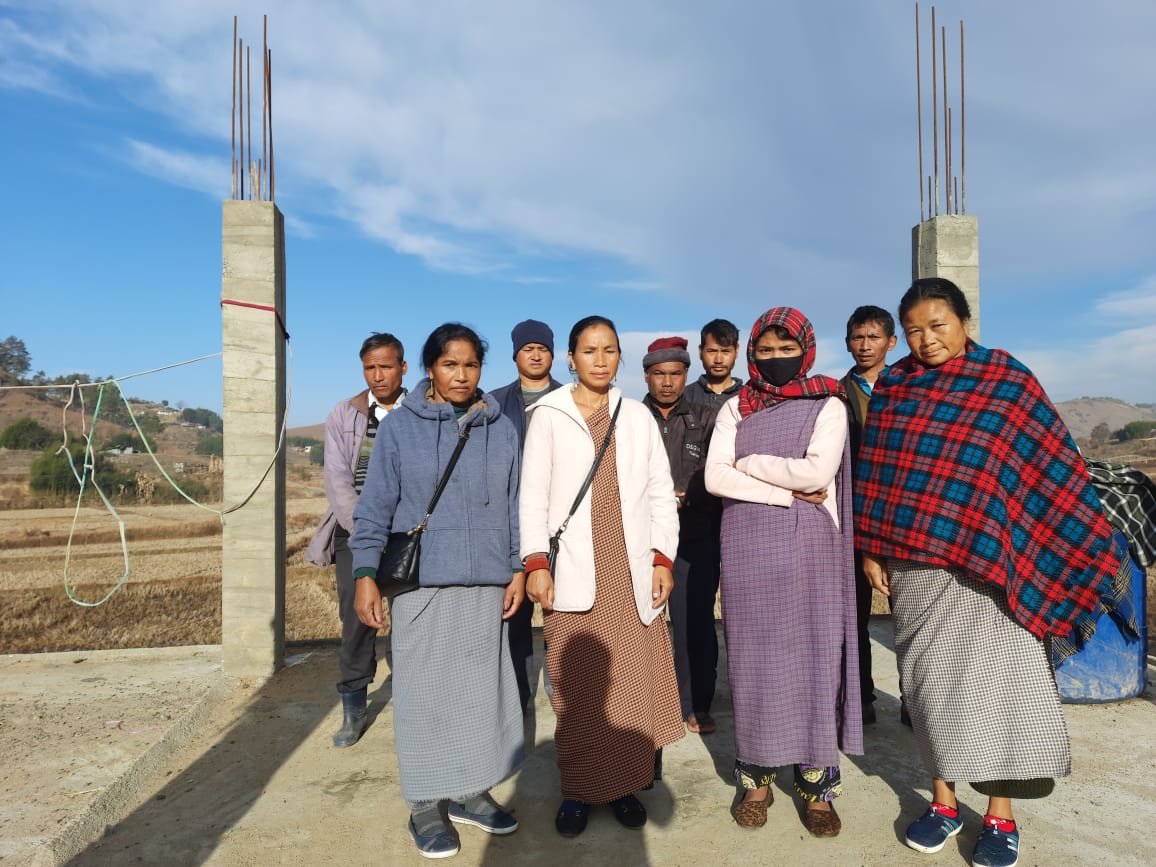
Fig 1: The Village Natural Resource Management Committee Members
| Village Community Facilitators | ||||||
|---|---|---|---|---|---|---|
| Sl. No | Name | Gender | Age | Education | Contact Number | Role |
| 1 | Aris Marngar | M | 28 | XII | 9862195927 | Vcf Social &KM |
| 2 | Evamilary Lyngkhoi | F | 26 | XII | 9378189366 | VCf Social |
| 3 | Convincer Lyngkhoi | M | 24 | X | 8837218830 | VCF Environment & GIS |
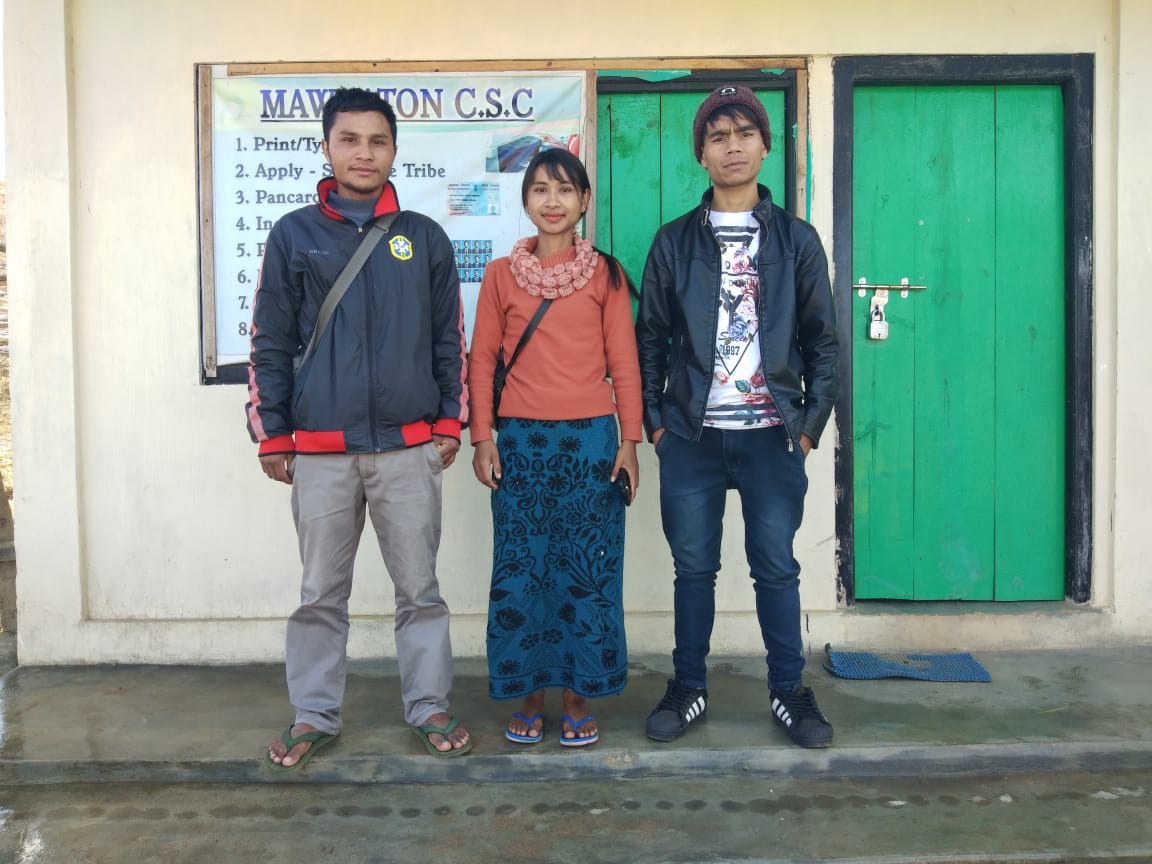
Fig 2: The Village Community Facilitators (VCFs)
| List of Purchase Members | |||||
|---|---|---|---|---|---|
| Sl.No. | Name | Gender | Age | Education | Contact No. |
| 1. | Amrose Lyngkhoi | M | 37 | BA | - |
| 2. | Seventis Marngar | M | 35 | X | - |
| 3. | Nicety Lyngkhoi |
F | 36 | X | - |
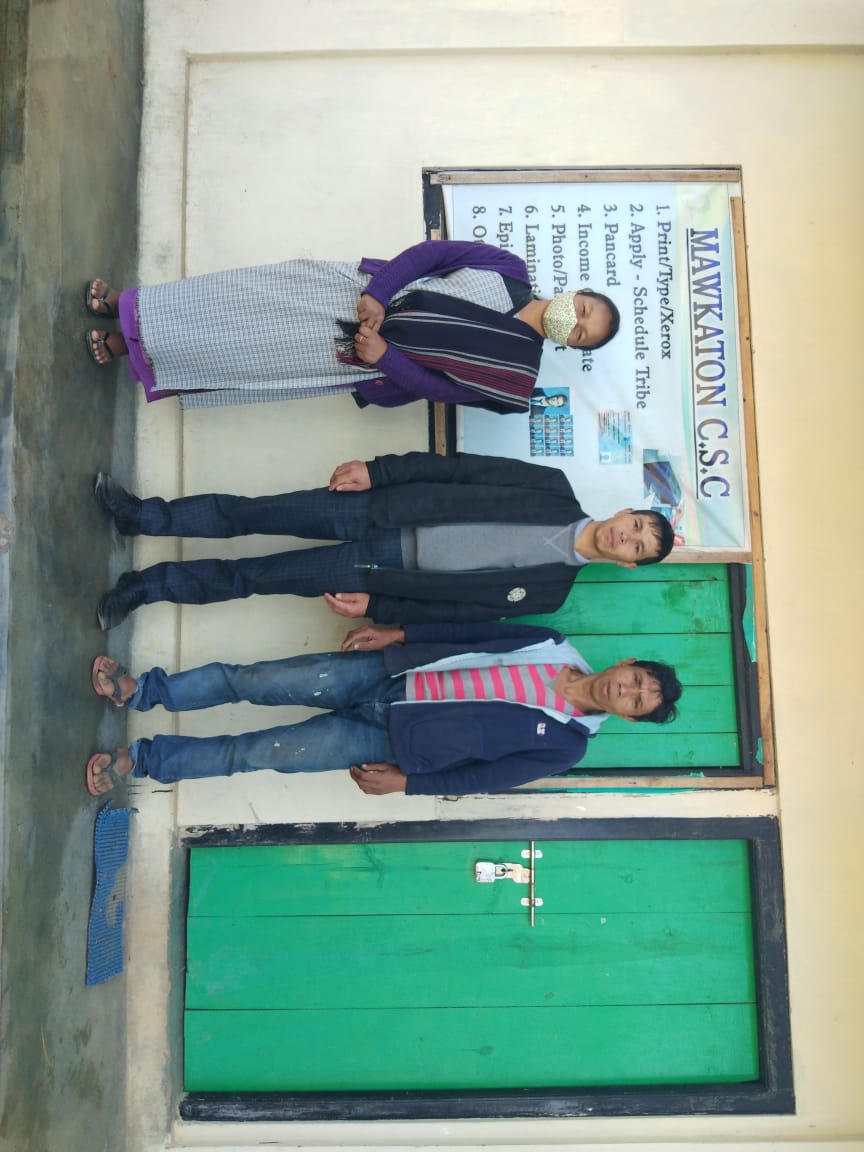
Fig3: Purchase Committee Members
3. Opening of Bank Account:
The opening of bank account was done after the signing of the EOI (expression of Interest), the Village Grant Agreement (VGA) and the signing of Green Charter at the respective villages.
A meeting was held for all the VNMRC members of Mawkaton to brief and assist them before opening the VNMRC bank account. The bank account was opened on 20th August 2019.
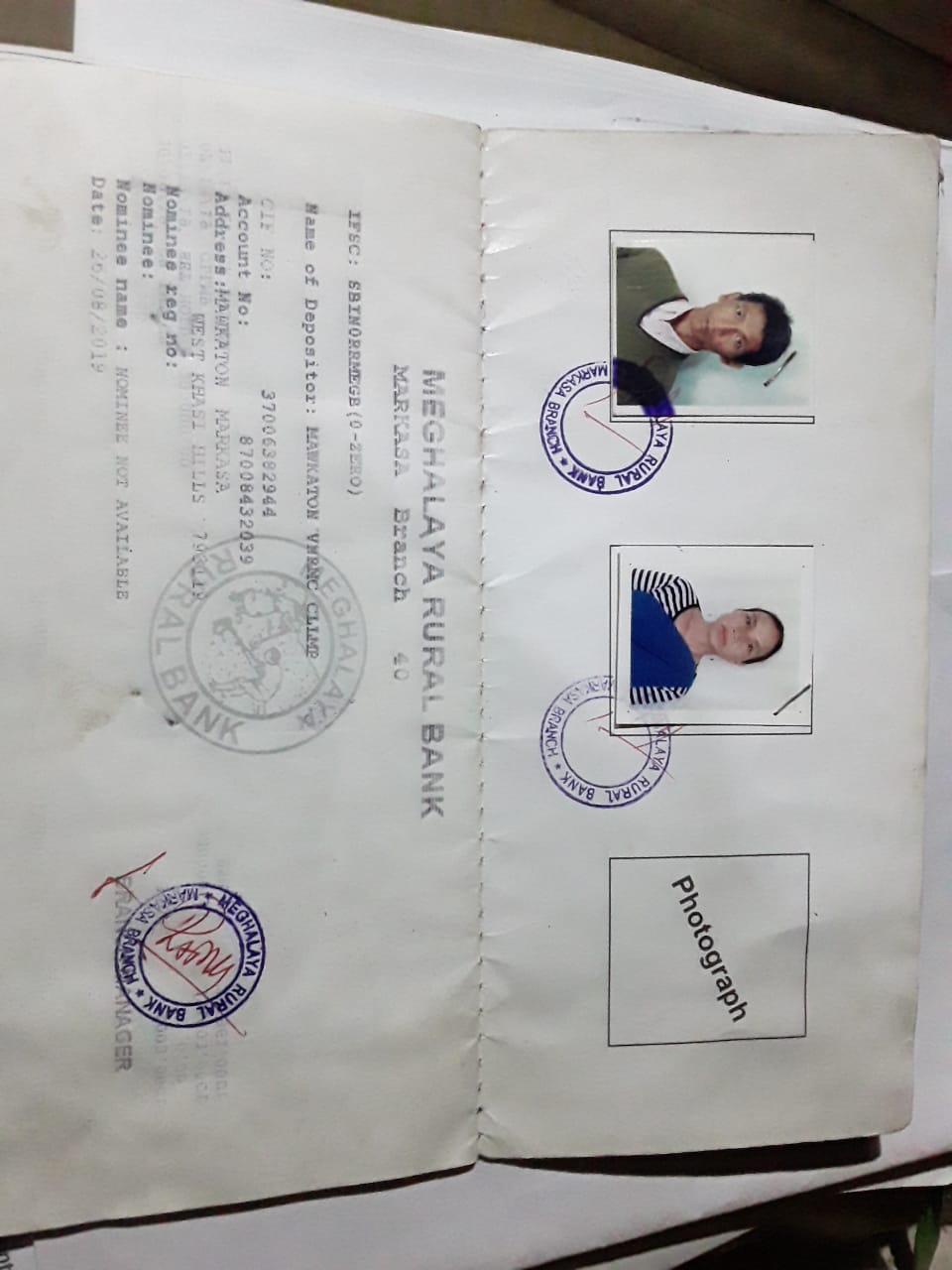
Fig.4. VNRMC Passbook
4. Participatory Rural Appraisal:
The PRA aims to incorporate the knowledge and opinions of the community in the planning and management of development projects and programs. The PRA exercise at Mawkaton village took place on the 9th July 2019 where a total of 60 villagers, men and women included took part in this exercise.
The initial stage of Participatory Rural Appraisal exercise at Mawkaton village commenced with a meeting cum orientation program on CLLMP. While conducting the meeting, the community members were made aware of the various PRA exercise conducted for the development of Community Natural Resource Management Plan (CNRMP) of the village, the community members contribution in the exercise and the objective to be achieved. The key informants- the VNMRC and the VCFs helped facilitate the maximum participation.
Commencement of PRA:
Introduction:
Participatory Rural Appraisal is the process of involving local people in the analysis and interpretation of their own situation of a given rural area. The local people i.e., the participants take a leadership role in collecting, analyzing interpreting, and presenting information and in this process impart knowledge and development insight to the specialist and extension agents for management of natural resources. Participatory Rural Appraisal is conducted to establish rapport with the village community as well as to identify and define problems for prioritization in the village itself. It is a way of learning from and with community members to investigate their need assessment, analyze and evaluate constraints and opportunities and find out priorities in the area of agriculture, small scale rural enterprises and any other social and economic development programs addressed to village development Based on the principle of listening and learning.
Objectives of PRA exercise at Mawkaton village:
The Participatory Rural Appraisal exercise at Mawkaton was conducted with following objectives:
To identify the natural human and economic resources of village
To identify the village problems and prioritize them with the help of community members.
To prepare the community natural resource Management Plan of the village.
Activity 4.1: Village Boundary Mapping and Drawing the Resource Map:
The GIS personnel along with the Village Community Facilitators mapped the village boundary of Mawkaton village.
The second step is to involve the local community in preparation of village resource map as perceived by the community members to solicit their participation, infrastructure, services, and other village resources such as agricultural lands, wells, wasteland, cattle population etc., were mapped. Local people prepared the resource map by drawing it on a chart paper without much interference of outsiders.
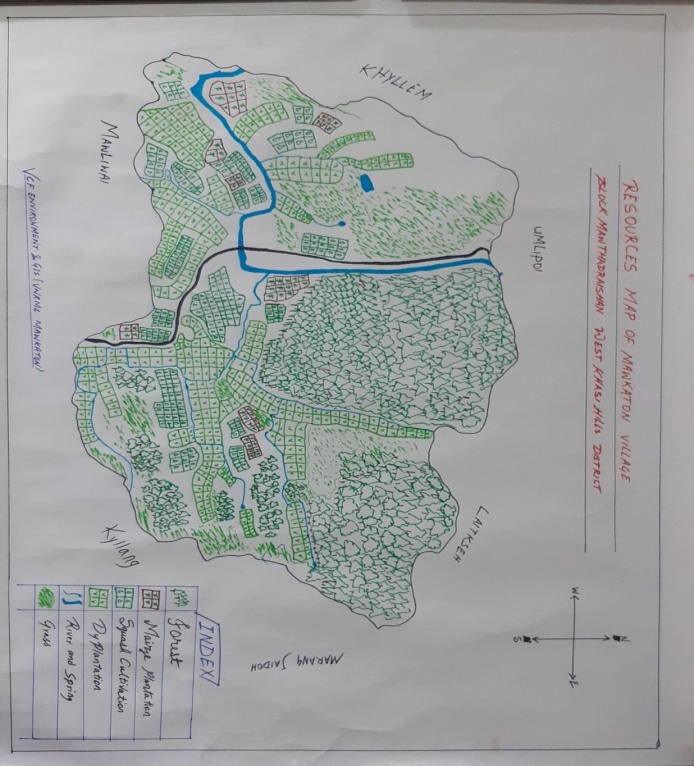
The activity achieved the following purposes:
Rapport building and won the confidence of the villagers.
Analyzed the spatial information particularly studied problems and opportunities of villagers.
Got an impression about the village setting physical layout location of various houses and institutions.
Finding based on the Resource Map of Mawkaton village:
Main agricultural crops are paddy, cauliflower, mustard and cayote.
Abundance of springs.
There are three types of forest i.e., community, Private and Clan Forest.
Kynshi river is the only river that flows in the village.
Presence of Integrated Child Development Services (ICDS).
Activity 2: Baseline Data survey to fill the Environment and Social Template
During the PRA exercise, the External Experts of Social & Environment Management held group discussion with different groups to gather basic village information regarding number of households, demographic information, major crops, and enterprises taken in the village, trends of production and productivity of major crops in the village and demographic distribution of village population.
Information related to land use category such as forest, cultivable land, water bodies, etc., and problems and challenges related to NRM were discussed.
Activity 3: Focused Group Discussion on Problem Analysis:
Do people have sufficient access to supply of fodder, fuel wood, leaf litter?
No, the people in the village does not have sufficient access to supply of fodder, fuel wood and leaf litter.
Has access to timber has reduced over the years? How is access for household use and commercial use managed?
Access to timber has reduced over the years. People in the village get it only from private land which is not enough. They must purchase it when needed.
Are the water bodies facing any threats?
Yes.
Do all people in the village have access to drinking water? What are the challenges?
No There is insufficient drinking water in especially in winter People have to fetch water from Kynshi river.
Are there degraded areas in the village (open/ degraded forests, mining affected, high soil erosion etc)?
Yes, open degraded forest.
What has caused this degradation? Are there practices causing threats to availability and access to natural resources?
Burning of fire during winter especially in open areas, this practice leads to decline of forest trees/crops.
What have been the changes in agricultural practices?
Use of chemical fertilizers, most of the farmers stick with the traditional practices of farming.
Are there any challenges in farming?
Yes, lack of water resources, use of chemical fertilizers.
How would you consider the health situation in your village?
Good.
How is the situation of cleanliness, sanitation, access to toilets and waste management?
Cleanliness, sanitation, and waste management has improved.
Who are the most vulnerable in the village? What can be done to improve their lives?
Widows and BPL.
What are the livelihood aspirations of the youth? Are there any avenues available?
Employment generation.
Do any committees/ Institutions/ rules exist to manage and monitor natural resource in the village?
The Executive committee of the Village Dorbar.
What are some of the major issues of conflict in the village?
No.
Have any of the above issues been discussed in village meetings?
No.
How do people resolve disagreement and conflicts
By mutual understanding.
Activity 4: Seasonality Calendar:
The CLLMP team also mapped the seasonal calendar of Mawkaton village to help identify heavy workload periods, periods of relative ease, credit crunch, diseases, food security, wage availability etc. This will prove helpful in project planning and project timeline framing.
| Seasonal Calendar | ||||||||||||||
|---|---|---|---|---|---|---|---|---|---|---|---|---|---|---|
| Sl.no | criteria | Jan | Feb | Mar | Apr | May | Jun | Jul | Aug | Sep | Oct | Nov | Dec | |
| 1 | Water Scarcity | 2 | 1 | 1 | 3 | 3 | 3 | 2 | ||||||
| 2 | Prone to sickness | 1 | 1 | 3 | ||||||||||
| 3 | Seeking job outside | 1 | 1 | 2 | 2 | |||||||||
| 4 | Rainfall | 1 | 1 | 1 | 2 | |||||||||
| 5 | Free-less work | 1 | 2 | |||||||||||
| 6 | Paddy cultivation | 1 | 1 | 2 | ||||||||||
| 7 | Paddy harvesting | 1 | 2 | |||||||||||
| 8 | Tree plantation | 1 | 2 | |||||||||||
| 9 | Vegetable crop plantation | 2 | 2 | 1 | 3 | |||||||||
| 10 | Vegetable harvesting | 2 | 2 | 1 | 1 | |||||||||
| 11 | Festive season | 1 | 2 | 2 | 1 | |||||||||
| 12 | Forest fire | 1 | 1 | 2 | ||||||||||
| 13 | Collection of wood | 1 | 2 | 1 | 2 | |||||||||
| Maximum | 1 |
|---|---|
| Medium | 2 |
| Less | 3 |
5. Submission of CNRMP:
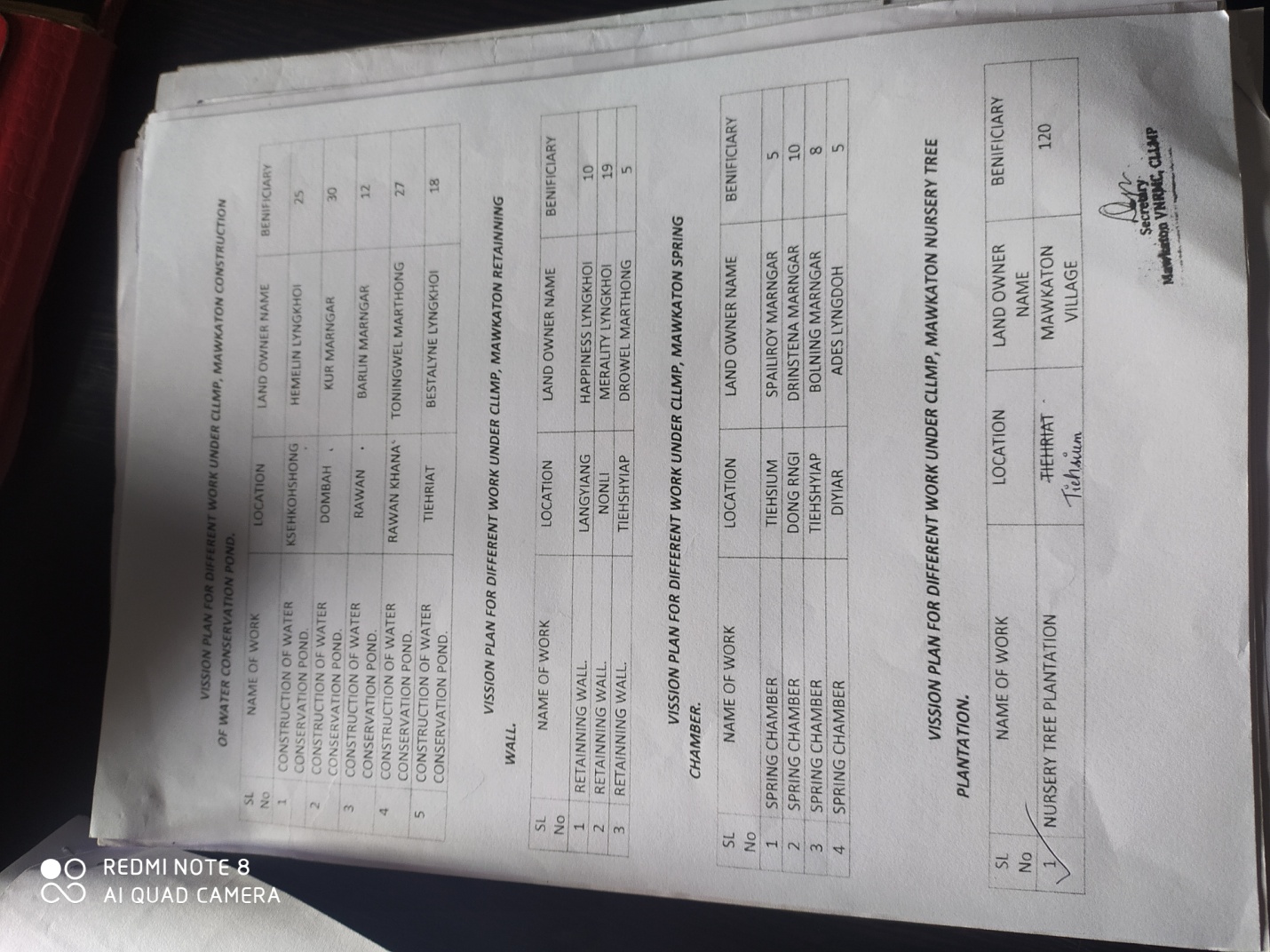
5.1. The Final Community Natural Resource Management Plan:
| Sl.No. | Name of proposed intervention | Site | Land ownership | Nos of HHS EXPECTED TO Benefit | Priority | ||
|---|---|---|---|---|---|---|---|
| BPL | APL | Total | |||||
| 1 | Construction of Water Conservation Pond | Ksehkohshong | Private | 15 | 10 | 25 | High |
| 2 | Construction of Water Conservation Pond | Dombah | Clan | 15 | 15 | 30 | High |
| 3 | Construction of Water Conservation Pond | Rawan | Private | 7 | 5 | 12 | High |
| 4 | Construction of Water Conservation Pond | Rawan khana | Private | 15 | 12 | 27 | High |
| 5 | Construction of Water Conservation Pond | Tiehriat | Private | 10 | 8 | 18 | High |
| 6 | Retaining wall | Langyiang | Private | 5 | 5 | 10 | High |
| 7 | Retaining wall | Nonli | Private | 10 | 9 | 19 | High |
| 8 | Retaining wall | Tiehshyiap | Private | 3 | 2 | 5 | High |
| 9 | Spring Chamber | Tiehsium | Private | 3 | 2 | 5 | High |
| 10 | Spring Chamber | Dong rngi | Private | 5 | 5 | 10 | High |
| 11 | Spring Chamber | Tiehshyiap | Private | 4 | 4 | 8 | High |
| 12 | Spring Chamber | Diyiar | Private | 3 | 2 | 5 | High |
6. GIS Activities:
| Sl.No | Parameters | Village information |
|---|---|---|
| 1 | GPS Coordinates | |
| i | Latitude | 25°.30°.15.92°N |
| ii | Longitude | 91°.23°.31.79°E |
| iii | Elevation Reading (MSL) | 1495m |
| 2 | Village Geographical Area (Ha) | |
| i | Total Forest Area including community,clan,pvt forest) | 52.49 ha |
| ii | Total area of water bodies | 5.65 ha |
| iii | Total area under agri-Horticulture | 53.03ha |
| iv | Total degraded land area (Ha) | 2.60ha |
| 3 | Average annual rainfall | |
| 4 | Soil Type |
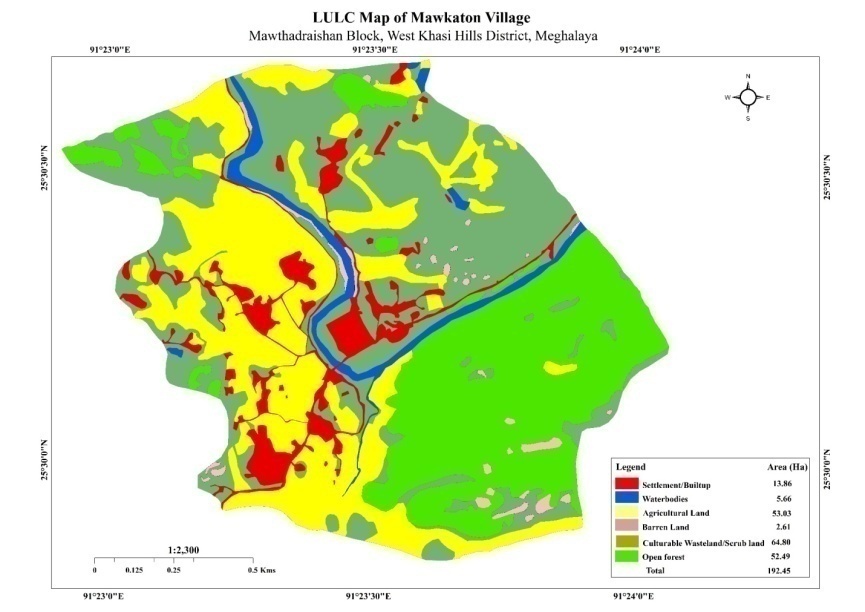
7. Project Implementation:
| 1 | Type of Intervention | Site Name | GPS- Coordinates | Amount Sanctioned | Work status | |
|---|---|---|---|---|---|---|
| Retaining wall | Langyiang | 25.512467 | 91.383938 | 3,40,000.00 | Completed | |
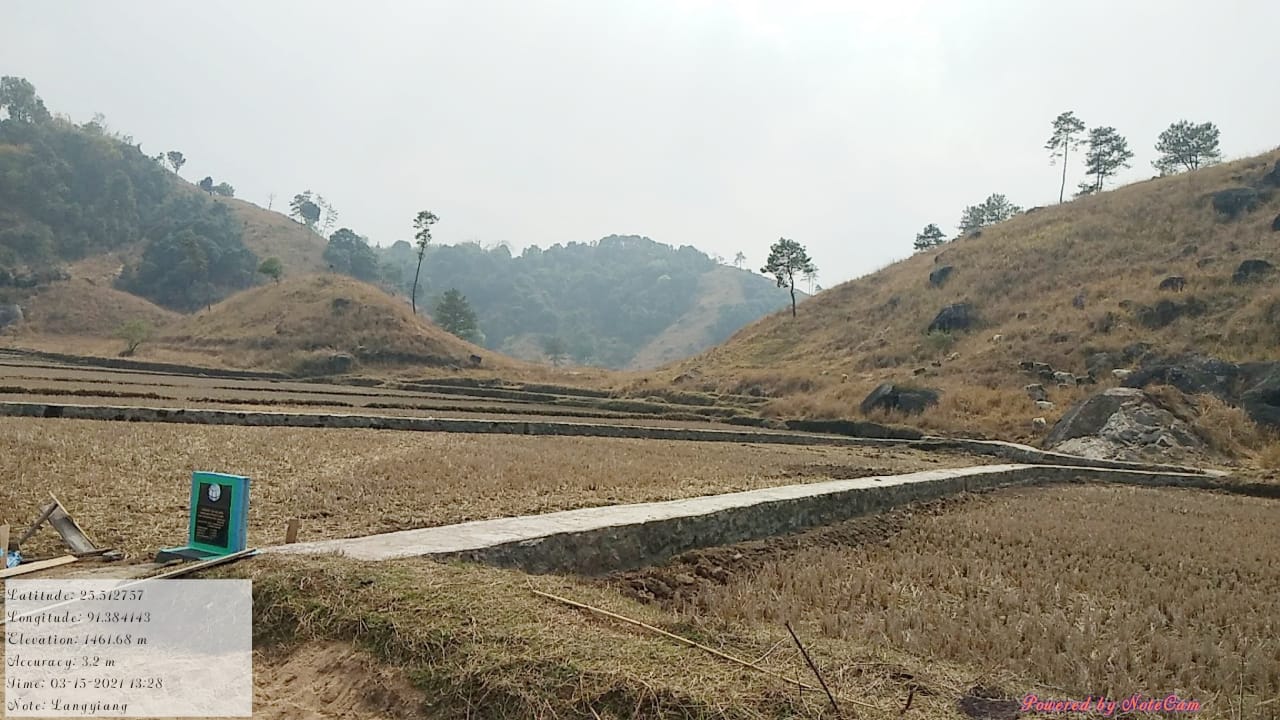
| 2 | Type of Intervention | Site Name | GPS- Coordinates | Amount Sanctioned | Work status | |
|---|---|---|---|---|---|---|
| Water Conservation Pond | Rawankhana | 25.4961 | 91.385144 | 5,00,000.00 | Completed | |

| 3 | Type of Intervention | Site Name | GPS- Coordinates | Amount Sanctioned | Work status | |
|---|---|---|---|---|---|---|
| Water Conservation Pond | Rawan | 25.49484 | 91.386542 | 2,47,000.00 | Completed | |
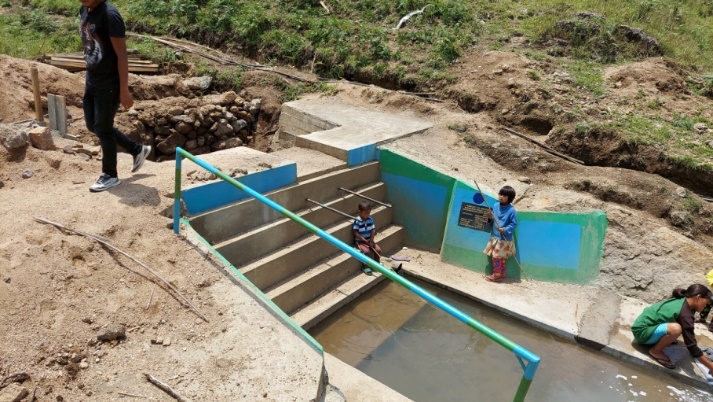
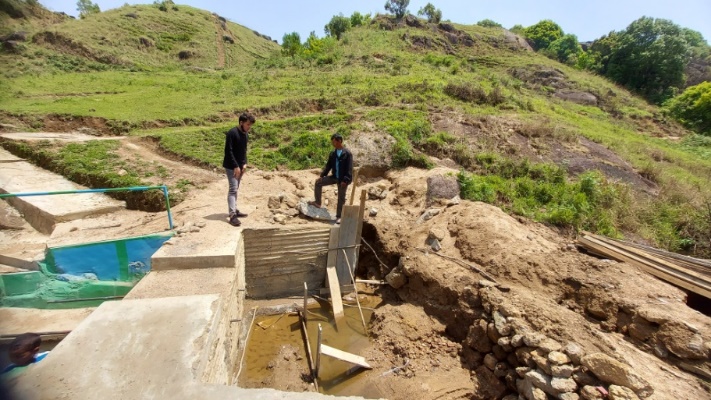
| 4 | Type of Intervention | Site Name | GPS- Coordinates | Amount Sanctioned | Work status | |
|---|---|---|---|---|---|---|
| Water conservation Pond | Dombah | 25.493365 | 91.392305 | 4,17,000.00 | Completed | |
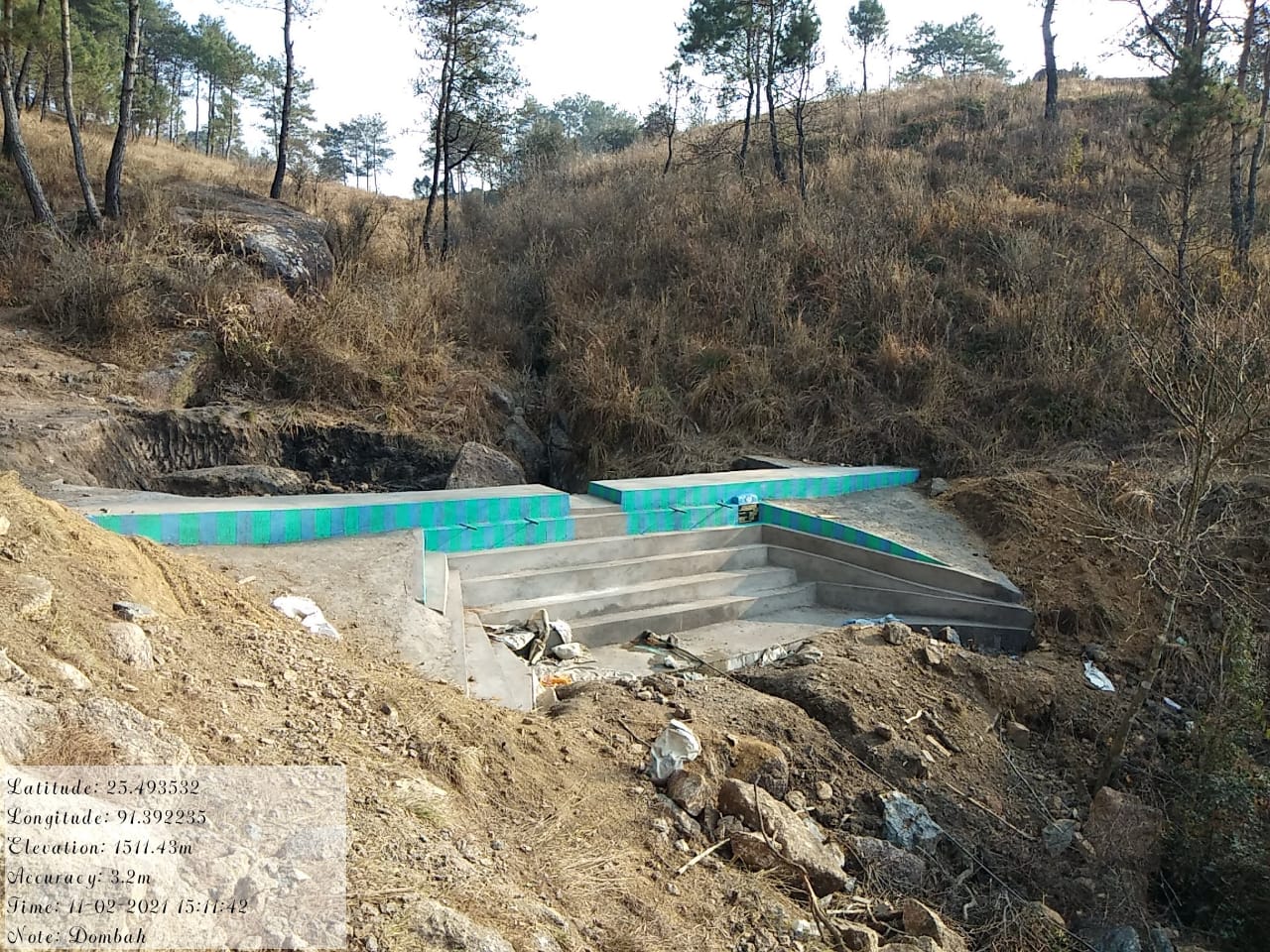
| 5 | Type of Intervention | Site Name | GPS- Coordinates | Amount Sanctioned | Work status | |
|---|---|---|---|---|---|---|
| Water Conservation Pond | Ksehkohshong | 25.505439 | 91.394016 | 4,86,000.00 | Completed | |
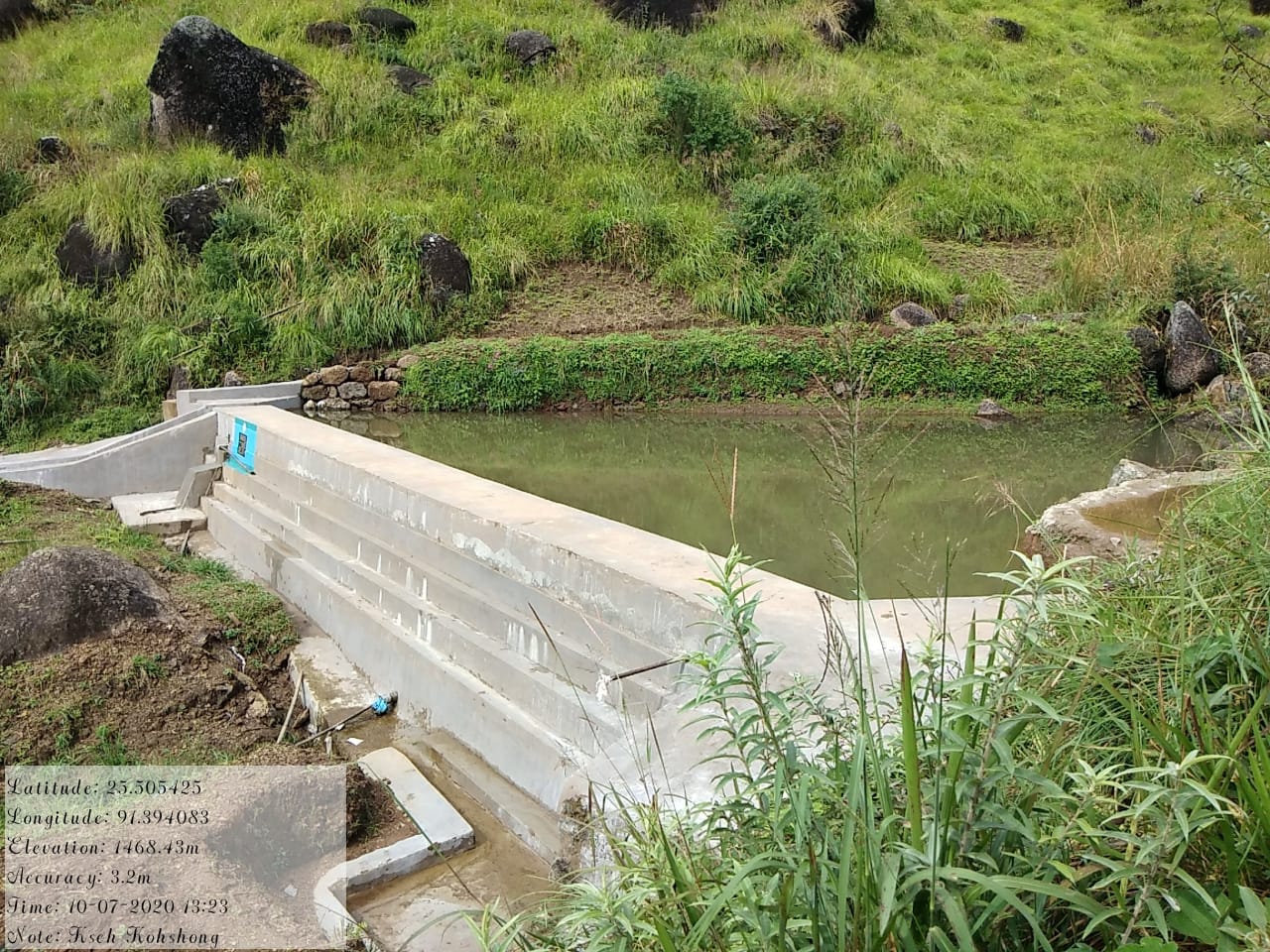
| 6 | Type of Intervention | Site Name | GPS- Coordinates | Amount Sanctioned | Work status | |
|---|---|---|---|---|---|---|
| Community Nursery | Tiehsiehum | 25.504496 | 91.389014 | 98,190.00 | Completed | |
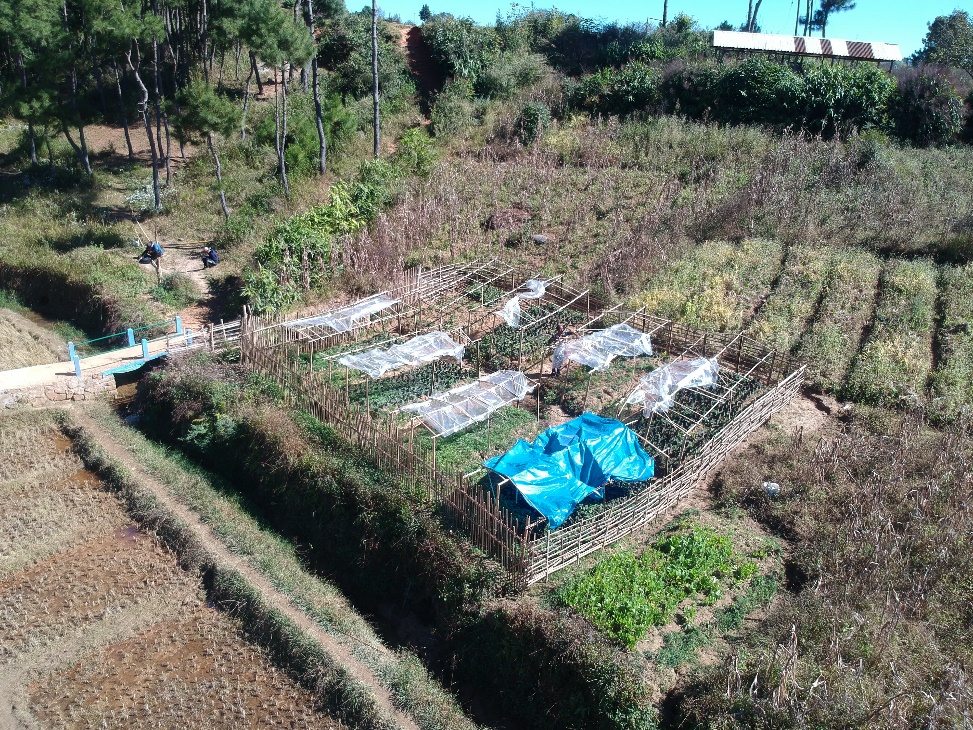
8. Fund Status:
| Fund released to VNRMC (Project Implementation | Total No. of work order issued | Total amount issued under CLLMP (per Activity) | Total Amount spent | Start Date | End Date |
|---|---|---|---|---|---|
| ₹26,28,759 | 11 | Retaining Wall | 3,36,587 | 12-Aug-20 | 25-Feb-21 |
| Water Conservation Pond | 4,96,138 | 12-Apr-20 | 20-Feb-21 | ||
| Water Conservation Pond | 2,44,846 | 11-Jun-20 | 31-Jul-20 | ||
| Water Conservation Pond | 4,12,991 | 20-Oct-20 | 30-Dec-20 | ||
| Water Conservation Pond | 4,81,660 | 11-Jun-20 | 31-Jul-20 | ||
| Community Nursery | 98,190 | 28-Aug-21 | 10-Mar-23 | ||
| Spring Chamber | 84,944 | 06-Jun-22 | 10-Aug-22 | ||
| Spring Chamber | 84,938 | 10-May-22 | 15-Jun-22 | ||
| Afforestation with Staggered Trenches (Afforestation) | 1,45,392 | 20-Jul-22 | 14-Mar-23 | ||
| Afforestation with Staggered Trenches (Trenches) | 4,608 | 20-Jul-22 | Ongoing | ||
| Erosion Control Retaining Wall | 2,38,465 | 26-Sep-22 | 02-Nov-22 | ||
| Total amount spent | ₹26,28,759 | ||||